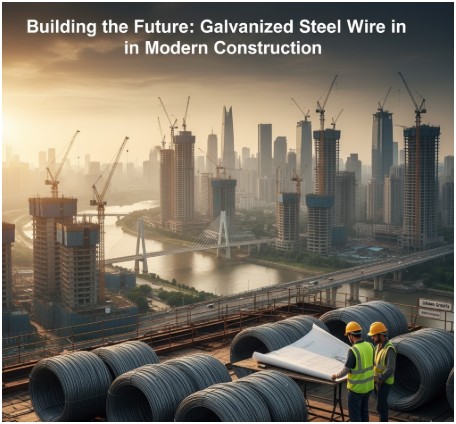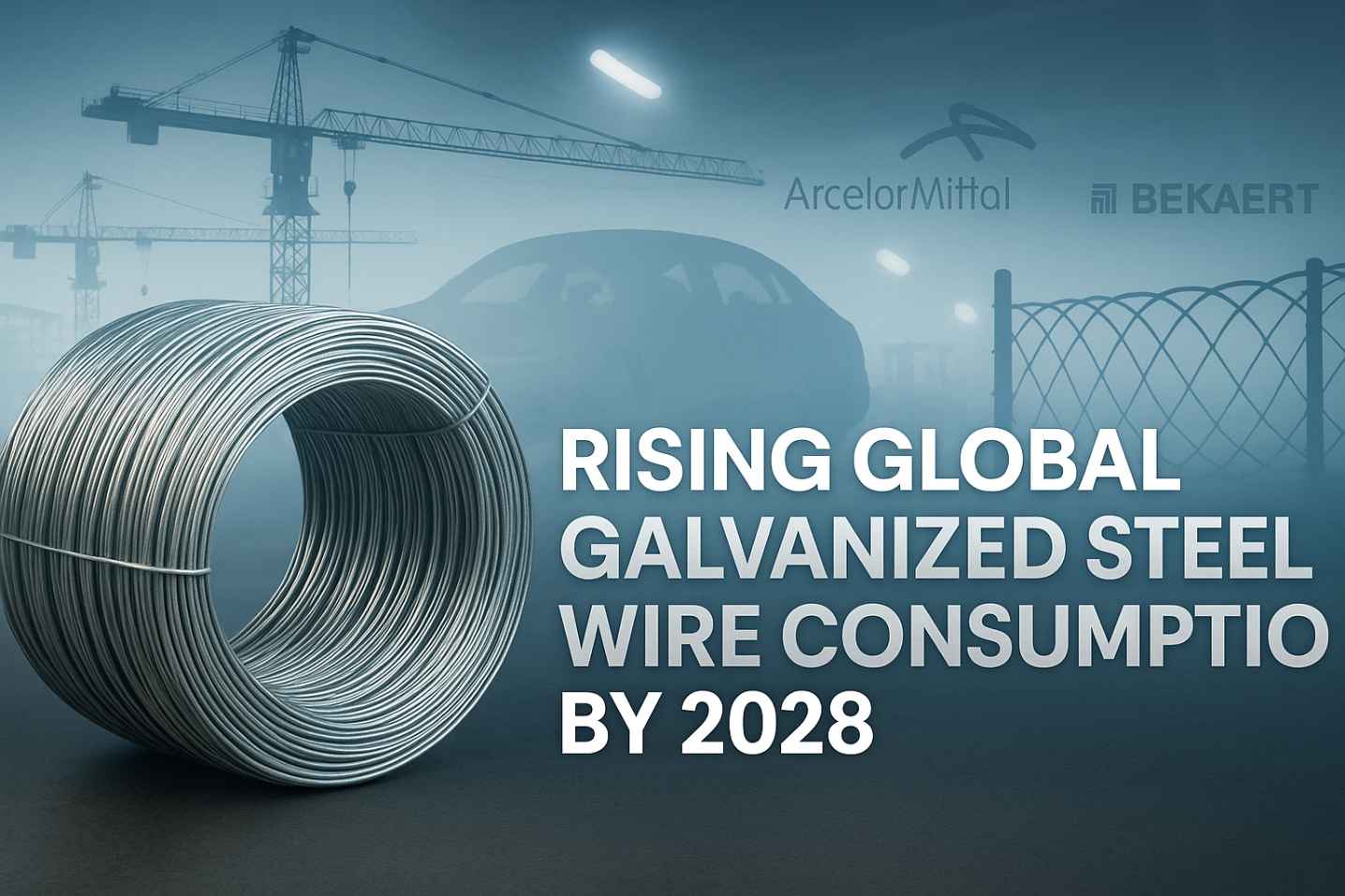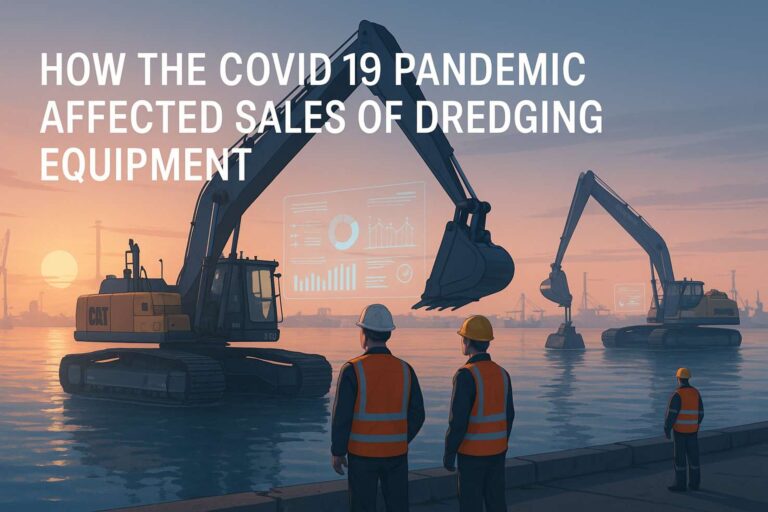I’ll admit it—I never thought I’d geek out over galvanized steel wire consumption. But here I am, sipping coffee and scrolling through reports that make my inner market analyst do a little happy dance.
I stumbled into this topic while helping a friend price materials for a fencing project, and one small curiosity led me down a rabbit hole of global construction growth, automotive innovation, and shiny zinc-coated steel that refuses to rust.
The more I read, the more I realized: galvanized steel wire isn’t just an industrial staple. It’s the unsung hero behind skyscrapers, bridges, EV components, and even farm fences. And as industries across the world modernize, the demand for this material keeps climbing—steadily and confidently—into 2028.
What’s Really Driving Global Galvanized Steel Wire Consumption?

The growth of galvanized steel wire consumption is powered by more than just infrastructure—it’s about durability meeting demand. Construction projects across Asia-Pacific, especially in China and India, are using it in everything from bridges to power grids.
Governments are pouring billions into roads and urban housing, and galvanized wire is holding much of it together—literally.
Then there’s the automotive industry. As electric vehicles take the spotlight, manufacturers need materials that can resist wear, shock, and corrosion.
Galvanized steel wire fits the bill perfectly. It’s also a star in the agricultural world, where it keeps livestock fencing, greenhouses, and irrigation systems strong against harsh weather.
When you think about it, this one material quietly strengthens the backbone of modern life—construction, mobility, and food production—all while staying resistant to rust.
How Fast Is the Galvanized Steel Wire Market Growing?

I found that estimates vary depending on who you ask, but the story is consistently optimistic. One source projects the global galvanized steel wire market to hit USD 14.1 billion by 2028, growing at a 4.0% to 5.1% CAGR. Another forecast covering the broader galvanized steel market predicts a whopping USD 51.2 billion size by the same year with a 5.34% CAGR.
To put it simply: while steel might sound like an “old” industry, its evolution keeps pace with the modern world. The rise of smart infrastructure, electric vehicles, and sustainable building materials gives galvanized wire a timeless yet forward-looking role.
Here’s a quick overview for context:
| Forecast Range | Market Size (2028) | Estimated CAGR (2023–2028) | Scope |
| USD 14.1 billion | 4.0%–5.1% | Galvanized Steel Wire Market | |
| USD 51.2 billion | 5.2%–5.34% | Broader Galvanized Steel Market |
That’s steady, reliable growth—something I like to call “industrial serenity.”
Why Is the Asia-Pacific Region Leading Galvanized Steel Wire Consumption?

If you’ve ever visited a fast-developing city in Asia, you know how quickly skylines change. The Asia-Pacific region dominates galvanized steel wire consumption because it’s building faster than anywhere else.
China, India, and Southeast Asia are undertaking massive construction and infrastructure projects—from high-speed rail to industrial parks—and all need corrosion-resistant materials.
Asia-Pacific’s manufacturing strength also plays a huge role. The region’s factories not only produce but consume galvanized wire for applications like automotive parts, electrical grids, and construction reinforcements.
Meanwhile, North America and Europe aren’t sitting idle. The U.S. is investing heavily in sustainable construction and EV manufacturing, while Europe emphasizes long-lasting, recyclable materials that align with environmental goals.
But Asia-Pacific’s growth rate still leads the pack, setting the global tone for production and innovation.
What Are the Challenges in the Galvanized Steel Wire Consumption Market?
No market’s story is perfect. Even with its impressive growth, galvanized steel wire consumption faces a few snags—pun intended.
Price volatility tops the list. Since steel and zinc prices fluctuate with global supply and demand, manufacturers sometimes struggle to maintain stable profit margins. Add to that competition from synthetic fibers and hybrid ropes, which are lighter and occasionally stronger in specific industries like mining and lifting.
There’s also the matter of technical challenges. Producing galvanized steel wire requires precision to ensure uniform zinc coating and prevent hydrogen embrittlement. Companies are investing in research to enhance coating technology, sustainability, and recyclability.
Still, with innovation driving solutions, most industry players see these as opportunities rather than obstacles.
How Are Key Players Shaping the Future of Galvanized Steel Wire Consumption?
Whenever I explore industrial markets, I like to look at the big players steering the ship. In this case, the galvanized steel wire market has some major names making waves:
- ArcelorMittal – A global steel giant leading in sustainable production methods.
- Tata Steel – A powerhouse from India driving Asia-Pacific’s market presence.
- Nucor – A U.S. brand known for innovation and eco-friendly steel production.
- Bekaert – Specializes in steel wire transformation and coatings.
- Kobe Steel and Sumitomo Metal Industries – Japanese leaders known for their precision engineering and technological advancement.
Together, these companies are modernizing the process with automation, greener production, and research into more durable, high-performance coatings. Their innovations are pushing galvanized steel wire consumption toward a smarter, cleaner future.
How to Understand Market Trends Like a Pro
If you’re like me and love decoding industrial growth, here’s a quick guide to understanding trends in galvanized steel wire consumption:
- Follow Infrastructure Investments: Big government projects signal demand spikes. If countries announce bridge or powerline expansions, wire consumption will rise.
- Track Automotive Shifts: The electric vehicle boom isn’t slowing down, and every EV plant adds to steel wire demand.
- Watch Raw Material Prices: Keep an eye on steel and zinc indexes—market volatility here impacts pricing downstream.
- Pay Attention to Regional Policies: Asia’s “build big” mindset and sustainability goals in Europe both shape how the market moves.
Understanding these levers helps predict how strong the next growth wave might be.
FAQs About Galvanized Steel Wire Consumption
Q1: Why is galvanized steel wire better than regular steel wire?
Because it resists corrosion. The zinc coating acts as a shield against rust, giving it a much longer lifespan—especially in outdoor or humid environments where standard steel would quickly degrade.
Q2: Which industries use galvanized steel wire the most?
Construction leads the way, followed by automotive, agriculture, and electrical infrastructure. From fencing to car frames and power grids, galvanized wire quietly supports nearly every modern sector.
Q3: What’s causing the increase in galvanized steel wire consumption?
Global infrastructure development and the demand for durable materials are key drivers. Rapid urbanization, EV production, and government investments in public works fuel steady growth.
Q4: Can galvanized steel wire be recycled?
Absolutely. Steel is one of the most recyclable materials on Earth, and the zinc coating can be recovered as well. This sustainability factor makes it a favorite for eco-conscious industries.
Steel Yourself for the Future
So, what did I learn after diving into galvanized steel wire consumption? That even the most overlooked materials can hold fascinating stories of innovation, resilience, and growth.
Behind every bridge, every EV frame, and every sturdy fence lies a bit of zinc-coated brilliance quietly doing its job.
If you ever catch yourself thinking construction materials are boring, think again. This market is alive, evolving, and—if trends hold steady—heading toward a multi-billion-dollar future.
My tip? Keep an eye on the Asia-Pacific region. That’s where the next big leap in industrial design, technology, and galvanized steel demand is already unfolding.









